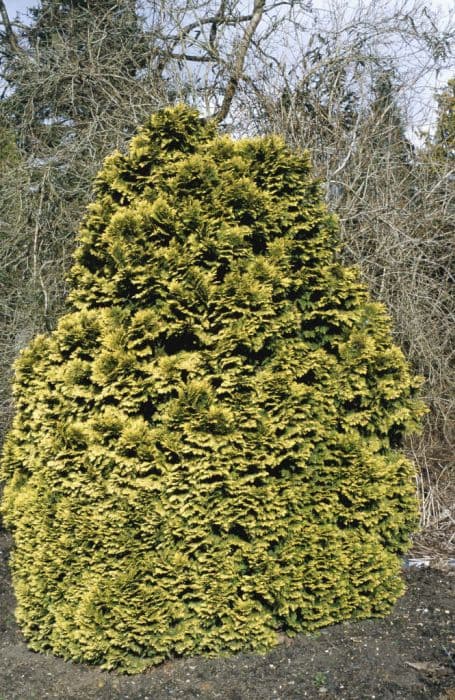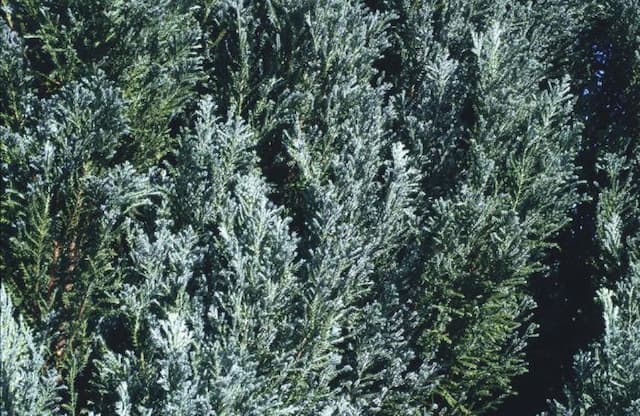Leyland cypress 'Gold Rider' × Cuprocyparis leylandii 'Gold Rider'

ABOUT
'Gold Rider' is a vigorous evergreen conifer making a large tree of narrowly conical habit. Foliage bright yellow, holding its colour well through the year
About this plant
 Names
NamesFamily
Cupressaceae
Synonyms
Gold Rider Leyland Cypress, Gold Rider Cypress
Common names
× Cupressocyparis leylandii 'Gold Rider'.
 Characteristics
CharacteristicsLife cycle
Perennials
Foliage type
Evergreen
Color of leaves
Golden
Height
20-25 feet (6-7.6 meters)
Spread
8-12 feet (2.4-3.6 meters)
Plant type
Tree
Hardiness zones
6
Native area
Hybrid
Benefits
 General Benefits
General Benefits- Fast Growth Rate: The Leyland Cypress 'Gold Rider' has a rapid growth rate, which makes it an ideal choice for quickly establishing privacy screens or hedges.
- Year-Round Interest: With its bright golden foliage that intensifies in winter, it provides visual interest throughout the seasons.
- Low Maintenance: Once established, it requires minimal care beyond occasional pruning to maintain its shape and size.
- Drought Tolerance: It is relatively drought-resistant, making it suitable for drier climates or water-wise gardens once established.
- Windbreak: Due to its dense foliage, it acts as an effective windbreak, protecting gardens and properties from strong winds.
- Noise Reduction: Its dense growth habit also makes the Leyland Cypress 'Gold Rider' good at absorbing sound, reducing noise pollution from roads or neighbors.
- Privacy: The height and density of the foliage provide excellent privacy, making it a popular choice for boundary plantings.
- Versatility: It can be planted in a variety of soil types, although it prefers well-drained soils, and it can adapt to partial shade or full sun.
 Medical Properties
Medical PropertiesThis plant is not used for medical purposes.
 Air-purifying Qualities
Air-purifying QualitiesThis plant is not specifically known for air purifying qualities.
 Other Uses
Other Uses- A natural sound barrier: Planting a row of 'Gold Rider' Leyland Cypress trees can help to muffle noise pollution due to their dense foliage.
- Windbreak: These trees can protect smaller, more fragile plants from strong winds when planted on the windward side of a garden or property.
- Privacy screen: Their rapid growth and tall stature make 'Gold Rider' Leyland Cypress ideal for creating a tall, natural privacy screen between properties.
- Erosion control: The root system of 'Gold Rider' Leyland Cypress can help stabilize soil on slopes and prevent erosion.
- Backdrop for garden vignettes: The golden foliage provides a vibrant background to make other plants, especially those with dark or red leaves, stand out.
- Seasonal decoration: Branches of 'Gold Rider' Leyland Cypress can be cut and used in festive wreaths or as part of holiday decorations.
- Theme gardens: They can be incorporated into themed gardens, such as a gold-themed garden due to their golden-hued leaves.
- Potted specimens: Young 'Gold Rider' Leyland Cypress can be grown in large pots to decorate patios, terraces, or as a temporary screening option.
- Insect habitat: These trees can provide shelter and breeding spots for beneficial garden insects, encouraging biodiversity.
- Training into topiary forms: 'Gold Rider' Leyland Cypress can be trained and pruned into various topiary shapes for an artistic element in the landscape.
Interesting Facts
 Feng Shui
Feng ShuiThe Leyland Cypress is not used in Feng Shui practice.
 Zodiac Sign Compitability
Zodiac Sign CompitabilityThe Leyland Cypress is not used in astrology practice.
 Plant Symbolism
Plant Symbolism- Resilience: Leyland cypress is known for its vigorous growth and hardy nature, representing the ability to thrive in various conditions.
- Longevity: With a lifespan that can reach several decades, this plant symbolizes enduring life and perseverance.
- Privacy: Often used as a privacy hedge, it represents the need for personal space and boundary-setting.
- Sanctuary: Its thick foliage provides a haven for birds and wildlife, symbolizing refuge and safety.
- Growth: The rapid growth rate of Leyland cypress stands for fast development and expansion in one's life.
 Water
WaterLeyland Cypress 'Gold Rider' should be watered deeply but infrequently, making sure the soil is moist but not waterlogged. Newly planted trees require watering once a week with about 5 gallons of water, depending on weather conditions. Once established, watering can be reduced to every few weeks, especially if there has been sufficient rainfall. During prolonged dry spells, you may need to water every 7-10 days. It is important to water the root zone rather than the foliage to prevent fungal diseases.
 Light
LightLeyland Cypress 'Gold Rider' thrives best in full sunlight but can tolerate partial shade. The ideal spot for this plant is an area that receives at least 6 to 8 hours of direct sunlight daily. Avoid planting in deeply shaded areas to ensure good growth and the golden coloring of its foliage.
 Temperature
TemperatureLeyland Cypress 'Gold Rider' can survive in temperatures as low as 0°F and tolerate heat up to around 100°F; however, its ideal temperature range is between 60°F and 80°F. It is generally hardy in USDA zones 6 through 10. The plant will suffer in temperatures below 0°F or prolonged periods of extreme heat above 100°F.
 Pruning
PruningLeyland Cypress 'Gold Rider' should be pruned for shaping or size control, ideally during late winter or early spring before new growth starts. Pruning can be done once a year to maintain the desired shape and size. Thinning out dense growth can also help improve airflow, reducing the risk of disease. Best time for pruning is usually outside of the birds' nesting season to avoid disturbing wildlife.
 Cleaning
CleaningAs needed
 Soil
SoilLeyland Cypress 'Gold Rider' prefers well-drained soil with a mix of peat, loam, and sand. The ideal soil pH for this conifer is slightly acidic to neutral, ranging from 6.0 to 8.0.
 Repotting
RepottingLeyland Cypress 'Gold Rider' is typically planted in the ground and does not require repotting. If grown in a container, repot every 2 to 3 years to refresh the soil.
 Humidity & Misting
Humidity & MistingLeyland Cypress 'Gold Rider' is adaptable but prefers average ambient humidity, typical of outdoor conditions.
 Suitable locations
Suitable locationsIndoor
Not ideal indoors; requires sun, space, and good air circulation.
Outdoor
Plant in sun, provide ample water and space, protect from strong winds.
Hardiness zone
6-10 USDA
 Life cycle
Life cycleLeyland Cypress 'Gold Rider' begins its life as a seed, which upon germination in suitable conditions, develops into a seedling with a primary root that anchors it into the soil and shoots that reach towards the light. As it grows into a sapling, it develops a sturdy trunk and begins to form the scale-like leaves that are characteristic of mature trees; this stage sees significant vertical and lateral growth. Maturing into an adult tree, 'Gold Rider' has a vigorous growth habit, and can quickly reach its mature height of up to 15 meters, displaying its golden-green, dense foliage that makes it popular for privacy screens and hedges. Throughout its life, it requires full sun and well-drained soil to thrive, with adequate moisture and occasional pruning to maintain shape and health. It is a long-lived perennial and may reproduce through cones, although it is often propagated vegetatively by cuttings for consistent traits. As the tree ages, it may become more susceptible to pests or diseases, and eventually, after several decades, it will die, completing its life cycle.
 Propogation
PropogationPropogation time
Late Winter to Early Spring
The Leyland Cypress 'Gold Rider' is predominantly propagated through semi-hardwood cuttings. This method involves taking cuttings from the current year's growth in late summer to early fall when the stems are partially matured and firmer. Cut a 4 to 6-inch (10 to 15 cm) length of stem, making the cut just below a node. Strip off the lower leaves, dip the cut end into a rooting hormone to encourage root development, and insert the cutting into a well-draining potting mix. The pot should be kept in a warm, humid environment with indirect sunlight. The cuttings typically root in several weeks, but it can take a few months before they are well-established and ready for transplanting. Maintaining proper moisture and avoiding direct sunlight are crucial for the success of this process.









